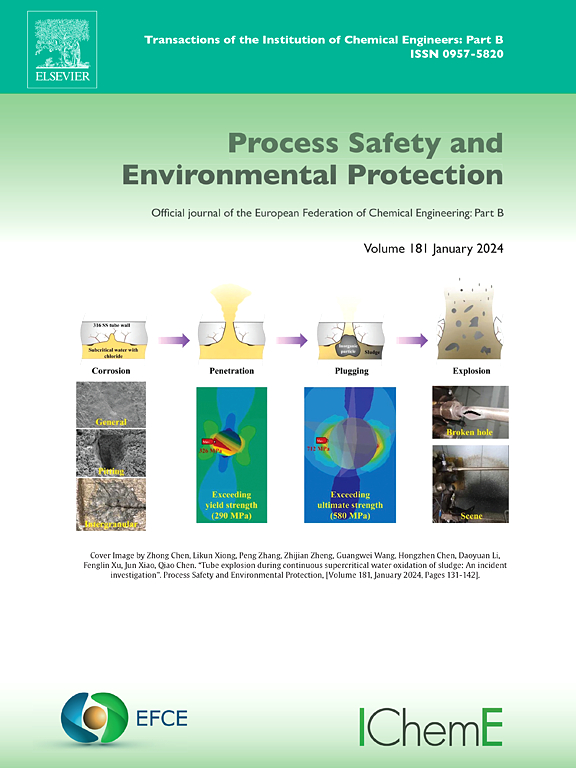臭氧微纳泡氧化浮选强化黄铜矿与辉钼矿的分离
IF 6.9
2区 环境科学与生态学
Q1 ENGINEERING, CHEMICAL
引用次数: 0
摘要
黄铜矿和辉钼矿由于具有相似的可浮性,在浮选分离中面临挑战。本研究利用臭氧微纳泡氧化黄铜矿和辉钼矿,改变其表面性质,促进其浮选分离。结果表明,臭氧微纳气泡氧化对黄铜矿的回收率有明显的降低,而辉钼矿则不受影响。在黄铜矿与辉钼矿不同质量比的人工混合浮选试验中,获得了Mo回收率稳定在84 %,Cu回收率低于9 %的精矿。x射线光电子能谱(XPS)、zeta电位和接触角分析结果表明,臭氧微纳泡氧化后黄铜矿表面被氧化形成金属氧化物和氢氧化物,从而降低了黄铜矿的可浮性。相反,辉钼矿的氧化产物溶解在矿浆中,保留了矿浆原有的表面和可浮性。此外,实验结果证实了微纳气泡比传统气泡具有更高的氧化效率和氧化速率。综上所述,臭氧微纳气泡氧化是一种很有前途的绿色方法,可以替代传统的抑制剂来高效分离硫化铜和硫化钼矿石。本文章由计算机程序翻译,如有差异,请以英文原文为准。
Enhancing separation of chalcopyrite and molybdenite via ozone micro-nano bubble oxidation and flotation
Chalcopyrite and molybdenite present challenges in flotation separation due to their similar floatability. In this study, ozone micro-nano bubble was employed to oxidize chalcopyrite and molybdenite, altering their surface properties to facilitate them separation via flotation. The flotation results demonstrated a significant reduction in the recovery of chalcopyrite through ozone micro-nano bubble oxidation, while molybdenite remained unaffected. The concentrates with the Mo recovery remained steady at 84 % and Cu recovery below 9 % were achieved in flotation experiments of the artificially mixed ores with various mass ratios of chalcopyrite and molybdenite. Analysis of the results from X-ray photoelectron spectroscopy (XPS), zeta potential, and contact angle measurements indicated that the surface of chalcopyrite was oxidized to form metal oxides and hydroxides after ozone micro-nano bubble oxidation, thereby decreasing its floatability. In contrast, the oxidation products of molybdenite dissolved in the pulp, preserving its original surface and floatability. Additionally, experimental results confirmed that micro-nano bubbles exhibited superior oxidation effectiveness and rate than those of conventional bubbles. In summary, ozone micro-nano bubble oxidation presented a promising green alternative to traditional depressants for the efficient separation of copper and molybdenum sulfide ore.
求助全文
通过发布文献求助,成功后即可免费获取论文全文。
去求助
来源期刊

Process Safety and Environmental Protection
环境科学-工程:化工
CiteScore
11.40
自引率
15.40%
发文量
929
审稿时长
8.0 months
期刊介绍:
The Process Safety and Environmental Protection (PSEP) journal is a leading international publication that focuses on the publication of high-quality, original research papers in the field of engineering, specifically those related to the safety of industrial processes and environmental protection. The journal encourages submissions that present new developments in safety and environmental aspects, particularly those that show how research findings can be applied in process engineering design and practice.
PSEP is particularly interested in research that brings fresh perspectives to established engineering principles, identifies unsolved problems, or suggests directions for future research. The journal also values contributions that push the boundaries of traditional engineering and welcomes multidisciplinary papers.
PSEP's articles are abstracted and indexed by a range of databases and services, which helps to ensure that the journal's research is accessible and recognized in the academic and professional communities. These databases include ANTE, Chemical Abstracts, Chemical Hazards in Industry, Current Contents, Elsevier Engineering Information database, Pascal Francis, Web of Science, Scopus, Engineering Information Database EnCompass LIT (Elsevier), and INSPEC. This wide coverage facilitates the dissemination of the journal's content to a global audience interested in process safety and environmental engineering.
 求助内容:
求助内容: 应助结果提醒方式:
应助结果提醒方式:


